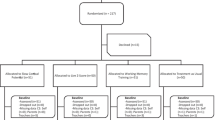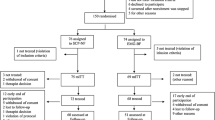Abstract
To assess the long-term effects of neurofeedback (NFB) in children with attention deficit hyperactivity disorder (ADHD), we compared behavioral and neurocognitive outcomes at a 6-month naturalistic follow-up of a randomized controlled trial on NFB, methylphenidate (MPH), and physical activity (PA). Ninety-two children with a DSM-IV-TR ADHD diagnosis, aged 7–13, receiving NFB (n = 33), MPH (n = 28), or PA (n = 31), were re-assessed 6-months after the interventions. NFB comprised theta/beta training on the vertex (cortical zero). PA comprised moderate to vigorous intensity exercises. Outcome measures included parent and teacher behavioral reports, and neurocognitive measures (auditory oddball, stop-signal, and visual spatial working memory tasks). At follow-up, longitudinal hierarchical multilevel model analyses revealed no significant group differences for parent reports and neurocognitive measures (p = .058–.997), except for improved inhibition in MPH compared to NFB (p = .040) and faster response speed in NFB compared to PA (p = .012) during the stop-signal task. These effects, however, disappeared after controlling for medication use at follow-up. Interestingly, teacher reports showed less inattention and hyperactivity/impulsivity at follow-up for NFB than PA (p = .004–.010), even after controlling for medication use (p = .013–.036). Our findings indicate that the superior results previously found for parent reports and neurocognitive outcome measures obtained with MPH compared to NFB and PA post intervention became smaller or non-significant at follow-up. Teacher reports suggested superior effects of NFB over PA; however, some children had different teachers at follow-up. Therefore, this finding should be interpreted with caution.
Clinical trial registration Train your brain and exercise your heart? Advancing the treatment for Attention Deficit Hyperactivity Disorder (ADHD), Ref. no. NCT01363544, https://clinicaltrials.gov/show/NCT01363544.

Similar content being viewed by others
References
American Psychiatric Association (2013) Diagnostic and statistical manual of mental disorders, 5th edn. American Psychiatric Association, Washington, DC
Alderson RM, Rapport MD, Kofler MJ (2007) Attention-deficit/hyperactivity disorder and behavioral inhibition: a meta-analytic review of the stop-signal paradigm. J Abnorm Child Psychol 35:745–758. https://doi.org/10.1007/s10802-007-9131-6
Lijffijt M, Kenemans JL, Verbaten MN, van Engeland H (2005) A meta-analytic review of stopping performance in attention-deficit/hyperactivity disorder: deficient inhibitory motor control? J Abnorm Psychol 114:216–222. https://doi.org/10.1037/0021-843X.114.2.216
Martinussen R, Hayden J, Hogg-Johnson S, Tannock R (2005) A meta-analysis of working memory impairments in children with attention-deficit/hyperactivity disorder. J Am Acad Child Adolesc Psychiatry 44:377–384
Willcutt EG, Doyle AE, Nigg JT et al (2005) Validity of the executive function theory of attention-deficit/hyperactivity disorder: a meta-analytic review. Biol Psychiatry 57:1336–1346. https://doi.org/10.1016/j.biopsych.2005.02.006
Faraone SV, Buitelaar J (2010) Comparing the efficacy of stimulants for ADHD in children and adolescents using meta-analysis. Eur Child Adolesc Psychiatry 19:353–364. https://doi.org/10.1007/s00787-009-0054-3
Coghill DR, Seth S, Pedroso S et al (2013) Effects of methylphenidate on cognitive functions in children and adolescents with attention-deficit/hyperactivity disorder: evidence from a systematic review and a meta-analysis. Biol Psychiatry. https://doi.org/10.1016/j.biopsych.2013.10.005
Graham J, Coghill D (2008) Adverse effects of pharmacotherapies for attention-deficit hyperactivity disorder: epidemiology, prevention and management. CNS Drugs 22:213–237
van de Loo-Neus GHH, Rommelse N, Buitelaar JK (2011) To stop or not to stop? How long should medication treatment of attention-deficit hyperactivity disorder be extended? Eur Neuropsychopharmacol 21:584–599. https://doi.org/10.1016/j.euroneuro.2011.03.008
Gevensleben H, Rothenberger A, Moll GH, Heinrich H (2012) Neurofeedback in children with ADHD: validation and challenges. Expert Rev Neurother 12:447–460. https://doi.org/10.1586/ern.12.22
Lofthouse N, Arnold LE, Hersch S et al (2012) A review of neurofeedback treatment for pediatric ADHD. J Atten Disord 16:351–372. https://doi.org/10.1177/1087054711427530
Loo SK, Makeig S (2012) Clinical utility of EEG in attention-deficit/hyperactivity disorder: a research update. Neurotherapeutics 9:569–587. https://doi.org/10.1007/s13311-012-0131-z
Snyder SM, Hall JR (2006) A meta-analysis of quantitative EEG power associated with attention-deficit hyperactivity disorder. J Clin Neurophysiol 23:440–455
Banaschewski T, Brandeis D (2007) Annotation: what electrical brain activity tells us about brain function that other techniques cannot tell us—a child psychiatric perspective. J Child Psychol Psychiatry 48:415–435. https://doi.org/10.1111/j.1469-7610.2006.01681.x
Arns M, de Ridder S, Strehl U et al (2009) Efficacy of neurofeedback treatment in ADHD : the effects on inattention, impulsivity and hyperactivity: a meta-analysis. Clin EEG Neurosci 40:180–189
Sonuga-Barke EJS, Brandeis D, Cortese S et al (2013) Nonpharmacological interventions for ADHD: systematic review and meta-analyses of randomized controlled trials of dietary and psychological treatments. Am J Psychiatry 170:275–289. https://doi.org/10.1176/appi.ajp.2012.12070991
Geladé K, Janssen TWP, Bink M et al (2016) Behavioral effects of neurofeedback compared to stimulants and physical activity in attention-deficit/hyperactivity disorder: a randomized controlled trial. J Clin Psychiatry 77:e1270–e1277. https://doi.org/10.4088/JCP.15m10149
Geladé K, Bink M, Janssen TWP et al (2016) An RCT into the effects of neurofeedback on neurocognitive functioning compared to stimulant medication and physical activity in children with ADHD. Eur Child Adolesc Psychiatry. https://doi.org/10.1007/s00787-016-0902-x
Molina BSG, Hinshaw SP, Swanson JM et al (2009) The MTA at 8 years: prospective follow-up of children treated for combined-type ADHD in a multisite study. J Am Acad Child Adolesc Psychiatry 48:484–500. https://doi.org/10.1097/CHI.0b013e31819c23d0
Jensen PS, Arnold LE, Swanson JM et al (2007) 3-year follow-up of the NIMH MTA study. J Am Acad Child Adolesc Psychiatry 46:989–1002. https://doi.org/10.1097/CHI.0b013e3180686d48
Bink M, Bongers IL, Popma A et al (2016) 1-year follow-up of neurofeedback treatment in adolescents with attention-deficit hyperactivity disorder: randomised controlled trial. Br J Psychiatry Open 2:107–115. https://doi.org/10.1192/bjpo.bp.115.000166
Steiner NJ, Frenette EC, Rene KM et al (2014) In-school neurofeedback training for ADHD: sustained improvements from a randomized control trial. Pediatrics 133:483–492. https://doi.org/10.1542/peds.2013-2059
Gevensleben H, Holl B, Albrecht B et al (2010) Neurofeedback training in children with ADHD: 6-month follow-up of a randomised controlled trial. Eur Child Adolesc Psychiatry 19:715–724. https://doi.org/10.1007/s00787-010-0109-5
Moreno-García I, Delgado-Pardo G, Camacho-Vara de Rey C et al (2015) Neurofeedback, pharmacological treatment and behavioral therapy in hyperactivity: multilevel analysis of treatment effects on electroencephalography. Int J Clin Health Psychol 15:217–225. https://doi.org/10.1016/j.ijchp.2015.04.003
Pelham WE, Gnagy EM, Greensalade KE, Milich R (1992) Teacher ratings of DSM-III-R symptoms for the disruptive behavior disorders. J Am Acad Child Adolesc Psychiatry 31:210–218
Kaufman AS, Kaufman JC, Balgopal R, Mclean JE (1996) Comparison of three WISC-III short forms: weighing psychometric, clinical, and practical factors. J Clin Child Psychol 25:97–105. https://doi.org/10.1207/s15374424jccp2501
Dallal GE (2007) Randomization plan generator: first generator. http://www.randomization.com. Accessed 12 May 2009
Swanson JM, Kraemer HC, Hinshaw SP et al (2001) Clinical relevance of the primary findings of the MTA: success rates based on severity of ADHD and ODD symptoms at the end of treatment. J Am Acad Child Adolesc Psychiatry 40:168–179. https://doi.org/10.1097/00004583-200102000-00011
Greenhill LL, Halperin JM, Abikoff H (1999) Stimulant medications. J Am Acad Child Adolesc Psychiatry 38:503–512
Goodman R, Meltzer H, Bailey V (1998) The strengths and difficulties questionnaire: a pilot study on the validity of the self-report version. Eur Child Adolesc Psychiatry 7:125–130
Goodman R (1997) The strengths and difficulties questionnaire: a research note. J Child Psychol Psychiatry 38:581–586
Swanson J, Schuck S, Mann M et al (2001) Categorical and dimensional definitions and evaluations of symptoms of ADHD: the SNAP and the SWAN rating scales. http://www.adhd.net. Accessed 24 Nov 2009
Barry RJ, Clarke AR, Johnstone SJ (2003) A review of electrophysiology in attention-deficit/hyperactivity disorder: I. Qualitative and quantitative electroencephalography. Clin Neurophysiol 114:171–183
Logan GD (1994) On the ability to inhibit thought and action: a user’s guide to the stop signal paradigm. Academic Press, San Diego
Alloway TP, Gathercole SE, Pickering SJ (2006) Verbal and visuospatial short-term and working memory in children: are they seperable? Child Dev 77:1698–1716
Westerberg H, Hirvikoski T, Forssberg H, Klingberg T (2004) Visuo-spatial working memory span: a sensitive measure of cognitive deficits in children with ADHD. Child Neuropsychol 10:155–161
Bruni O, Ottaviano S, Guidetti V et al (1996) The Sleep Disturbance Scale for Children (SDSC): construction and validation of an instrument to evaluate sleep disturbances in childhood and adolescence. J Sleep Res 5:251–261
Janssen TWP, Bink M, Geladé K et al (2016) A randomized controlled trial investigating the effects of neurofeedback, methylphenidate, and physical activity on event-related potentials in children with attention-deficit/hyperactivity disorder. J Child Adolesc Psychopharmacol. https://doi.org/10.1089/cap.2015.0144
Janssen TWP, Bink M, Weeda WD et al (2016) Learning curves of theta/beta neurofeedback in children with ADHD. Eur Child Adolesc Psychiatry. https://doi.org/10.1007/s00787-016-0920-8
Janssen TWP, Bink M, Geladé K et al (2016) A randomized controlled trial into the effects of neurofeedback, methylphenidate, and physical activity on EEG power spectra in children with ADHD. J Child Psychol Psychiatry. https://doi.org/10.1111/jcpp.12517
IBM Corp (2011) IBM SPSS Statistics for Windows, Version 20.0. IBM Corp, Armonk, NY
Meisel V, Servera M, Garcia-Banda G et al (2013) Neurofeedback and standard pharmacological intervention in ADHD: a randomized controlled trial with six-month follow-up. Biol Psychol 94:12–21. https://doi.org/10.1016/j.biopsycho.2013.09.009
Arns M, Kenemans JL (2012) Neurofeedback in ADHD and insomnia: vigilance stabilization through sleep spindles and circadian networks. Neurosci Biobehav Rev. https://doi.org/10.1016/j.neubiorev.2012.10.006
Duric NS, Assmus J, Gundersen D et al (2017) Multimodal treatment in children and adolescents with attention-deficit/hyperactivity disorder: a 6-month follow-up. Nord J Psychiatry. https://doi.org/10.1080/08039488.2017.1305446
Li L, Yang L, Zhuo C, Wang Y-F (2013) A randomised controlled trial of combined EEG feedback and methylphenidate therapy for the treatment of ADHD. Swiss Med Wkly 143:w13838. https://doi.org/10.4414/smw.2013.13838
Arns M, Conners CK, Kraemer HC (2013) A decade of EEG theta/beta ratio research in ADHD: a meta-analysis. J Atten Disord 17:374–383
Loo SK, Cho A, Hale TS et al (2013) Characterization of the theta to beta ratio in ADHD: identifying potential sources of heterogeneity. J Atten Disord 17:384–392
Snyder SM, Rugino TA, Hornig M, Stein MA (2015) Integration of an EEG biomarker with a clinician’s ADHD evaluation. Brain Behav. https://doi.org/10.1002/brb3.330
Arns M, Heinrich H, Strehl U (2014) Evaluation of neurofeedback in ADHD: the long and winding road. Biol Psychol 95:108–115. https://doi.org/10.1016/j.biopsycho.2013.11.013
Acknowledgements
We wish to thank all participating children and their families for their contribution, as well as all research interns for their valuable support. Furthermore, we would like to thank the participating centers of child and adolescent psychiatry: Yulius Academie, Groene Hart ziekenhuis, Lucertis, Alles Kits, GGZ Delfland, Maasstad ziekenhuis, RIAGG Schiedam, Kinderpraktijk Zoetermeer, Albert Schweitzer ziekenhuis, Groos Mentaal Beter Jong, ADHD behandelcentrum, GGZ inGeest, and PuntP.
Author information
Authors and Affiliations
Corresponding author
Ethics declarations
Conflict of interest
On behalf of all authors, the corresponding author states that there is no conflict of interest.
Funding source
This trial was funded by the Netherlands Organization for Health Research and Development (ZonMw): 157 003 012. ZonMw funded the trial, but had no role in the data analysis, manuscript preparation or decision to publish.
Electronic supplementary material
Below is the link to the electronic supplementary material.
Rights and permissions
About this article
Cite this article
Geladé, K., Janssen, T.W.P., Bink, M. et al. A 6-month follow-up of an RCT on behavioral and neurocognitive effects of neurofeedback in children with ADHD. Eur Child Adolesc Psychiatry 27, 581–593 (2018). https://doi.org/10.1007/s00787-017-1072-1
Received:
Accepted:
Published:
Issue Date:
DOI: https://doi.org/10.1007/s00787-017-1072-1




